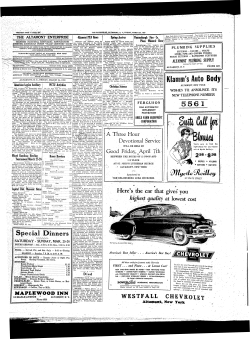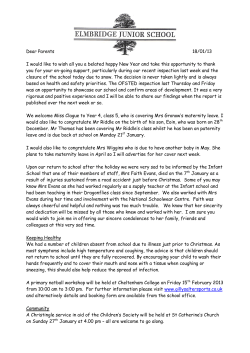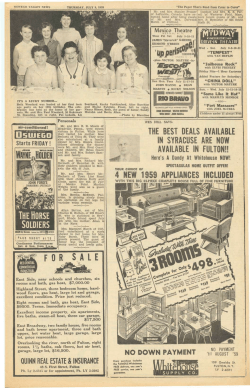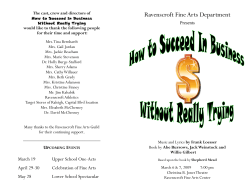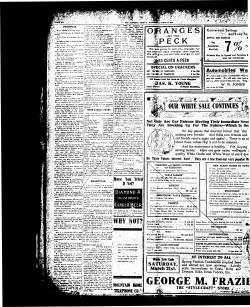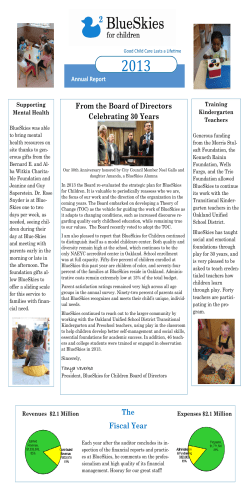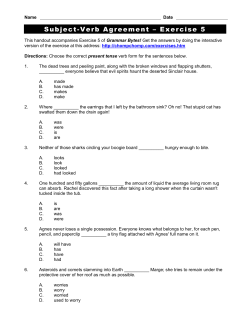
Teacher Work Sample Presented To: Dr. Patricia A. Smith, Instructor
Teacher Work Sample Presented To: Dr. Patricia A. Smith, Instructor In Partial Fulfillment of the Requirements for Student Teaching Prairie View A&M University College of Education Department of Curriculum and Instruction Spring Semester 2012 Charity S. Nwankpa 1095 April 24, 2012 10950501 EC-6 Generalist 1 Prairie View A&M University – Whitlowe R. Green College of Education Teacher Work Sample Cover Page Date Submitted Name Spring 2012 Charity S. Nwankpa TWS ID Number Permanent Address 10950501 10607 Plum Lake Dr. Houston, TX 77065 *Certification (i.e., EC-4) Interdisciplinary Studies, EC-6 Generalist *Specialization/Teaching Field University Supervisor Generalist Mr. Elvin Price Student Teaching Campus Metcalf Elementary School Cypress-Fairbanks Independent School District School District 4th grade TWS classroom - grade level(s) TWS subject(s) taught KMMM Read 180 Language Arts ___________________________________________________________________ I agree and testify that all materials included in this Teacher Work Sample were completed by me. I understand that submission of materials identical to those of another teacher education student constitutes academic dishonesty and may lead to dismissal from the teacher education program. (I also grant permission for my TWS to be used for faculty research and as an example for future education students.) Signature: ____________________________________ Teacher Candidate Date: __________________ Signature: ____________________________________ Cooperating Teacher Date: __________________ 10950501 EC-6 Generalist 2 Table of Contents Section 1 Learning Context………………………....pgs. 4 – 12 Section 2 Learning Goal & Objectives……………...pgs. 13 – 15 Section 3 Assessment Plan………………………….pgs. 16 – 20 Section 4 Design for Instruction…………………….pgs. 21 – 23 Section 5 Instructional Decision-Making…………...pgs. 24 – 27 Section 6 Analysis of Student Learning…………….pgs. 28 – 32 Section 7 Reflections & Self Evaluation……………pgs. 33 – 37 References ……..…………………………pg. 38 10950501 EC-6 Generalist 3 10950501 EC-6 Generalist 4 Learning Context Instructional Implications of the Community There are many factors that could affect the atmosphere of a school, one being where it is located. The northwest part of Houston, which is where Cypress-Fairbanks Independent School District (CFISD/Cy-Fair ISD) is prominent in its educational endeavors, is considered to be a suburb of the city of Houston. The area has fairly new developments and is still growing every year. CFISD has been in existence for over 40 years. Metcalf Elementary is one of 52 elementary schools in the Cy-Fair ISD which is located in Harris county. CFISD is considered to be a “community of great diversity that crosses racial, ethnic, religious, and cultural boundaries” (CFISD Substitute Handbook, 2011). Metcalf is located in an area surrounded by local business, houses, and apartments. One local venue, The Church Without Walls is practically two minutes away from the elementary school. The church allows the school to participate in competitions, such as the “I Have a Dream” poem that students have to compete against one another in order to be recognized as one of the top students of Metcalf Elementary. Also, local daycares surrounding the school aid parents with after school care. Metcalf located on 6100 Queenston in Houston, TX. Metcalf Elementary School is considered to be a Title 1, in which majority of the students receive reduced or free lunch due to their families low income status. Demographics (as indicated in the 2010-11 AEIS Report) AFRICAN HISPANIC AMERICAN 16.7% 67.7% 10950501 EC-6 Generalist WHITE 8.3% NATIVE AMERICAN 0.1% ASIAN 5.5% PACIFIC ISLANDER 0.1% TWO OR MORE ECONOMICALLY RACES DISADVANTAGED 1.6% 82.0% 5 Demographics of Students at Metcalf Elementary African American Hispanic White Native American Asian Pacific Islander Two or More Races Pie Graph of Demographics Instructional Implications of the School Metcalf Elementary School opened its doors in 1990. The school was named after June and Roy Metcalf, who combined served a total of 65 years as both educators and administrators in Cypress-Fairbanks ISD. The school serves Pre-k to 5th grade students. Although the school is over 20 years old, it is in great condition, clean, and free of pest. Metcalf has a total number of 1,044 students in its school. There are a total number of 72 full time teachers and about 25 support personnel. There are eight people on the administrative staff. The average student to 10950501 EC-6 Generalist 6 teacher ratio is 16:1. There is one computer lab for the students to use once a week, schedule permitting. The school library is fully stocked with books in both English and Spanish. There is also a teacher resource room accessible for teachers to use. Metcalf does have a PTO that meets on a regular basis to create fundraisers for the students to participate in. The school also has student council and a stepping team called the “Boot Scooters”. There is no band or sporting team at this elementary campus. The overall environment of the school is warm and supportive. All of the teachers work on teams depending on the subject they teach. The administrative staff aids the teachers with the minimal behavioral problems from students and shows them appreciation by hosting staff lunch parties. Instructional Implications of the Classroom Metcalf Elementary School has a few contained classrooms, but majority of the classrooms are considered “open concept”. Open concept classrooms are classrooms that are only separated by book shelves or half of a barrier. This form of classroom is only successful when the teacher and surrounding teachers have strong classroom management because children can easily become distracted from noise outside of their own classroom. If I were to have my own classroom, I would rather have a closed, contained classroom to ensure the peaceful learning environment for my students. With open concept, you cannot control another person’s classroom. The classroom has seven tables, six of which are rectangular and parallel (three and three) to each other. In the middle of the classroom is the overhead projector and in front of the classroom is the Smart Board. There is a mini library shelf for students to peruse as well as the book shelf for the students that participate in the Scholastic Program READ 180. There are two computers and room for about six to seven laptops for the students to do their READ 180 interactive lessons. The entire classroom is filled with anchor charts with variety of colors as 10950501 EC-6 Generalist 7 well as other print rich items. The routine goes as follows: Large group instruction, separate into three small groups and rotate among groups, and lastly, another large group instruction. At each station they have 20-25 minutes to work on their assignment. If they need assistance, the assistant teacher or I would help them solve the problem. The students of this fourth grade class have the opportunity to use both small group and large group instruction to ensure that they are learning and grasping the concepts. Pictures of classroom are below: 10950501 EC-6 Generalist 8 10950501 EC-6 Generalist 9 Instructional Implications of the Classroom Teacher and Teacher Candidate Cooperating Teacher Mrs. King has worked in education for 24 years, nine of those in CFISD. She began her teaching career in Chicago, where she also served as an assistant principal for two years. Mrs. King received her B.A. in Government from Oberlin College and her M.A. in Educational Administration and Supervision from Roosevelt University. She holds Texas certifications in Early Childhood Education (Grades PK-KG), Elementary Self-Contained (Grades 1-8), English as a Second Language Supplemental (Grades PK-8), and Principal (Grades EC-12). She is also hold teaching and administrative certifications in Illinois. Mrs. King strives to improve the lives of my students by helping them improve their reading and writing skills. She tries to capture their attention with engaging lessons and interesting activities within a small group setting. Mrs. King works hard to help her students achieve their dreams. Student Teacher Charity Nwankpa is a 21 year old, African-American female from Houston, TX. She was born May 1, 1990 to Dr. Hope C. Luster and Mr. Ezinwa Nwankpa. She is currently at Prairie View A&M University in pursuit of a degree in Interdisciplinary Studies Early Childhood through 6th grade Generalist. Miss Nwankpa has passed both of certifications exams (PPR and Content) and will soon seek her certificate in EC – 6 Generalist. Charity’s experience with children has been molded at child care centers and through observing and tutoring at elementary schools in Waller Independent School District. She enjoys working in a class setting where children are able to have one on one time with the instructor to learn material, as in small groups. Miss Nwankpa is excited about the student teaching experience and plans on learning as much as she can from her cooperating teachers. She has recently been accepted into graduate school at 10950501 EC-6 Generalist 10 both Northwestern University and University of Texas at Austin for their Speech-Language Pathology program. Upon graduation, Miss Nwankpa plans on obtaining her master’s degree and becoming a Speech Pathologist. Instructional Implications of the Students There are 21 students in Mrs. King 4th grade READ 180 class. This class contains majority ELL students and a few students that have difficulty with English/Language Arts concepts. The class contains 13 boys and 8 girls. There ages range from nine to 11. Ten students out of the 21 live in a strictly Spanish speaking household. Due to a language barrier, the students are most successful in small group instruction because they feel more confident working one on one with the instructor. During large group instruction, some students shut down and become very reclusive because of previous criticisms from classmates. Mrs. King encourages all of her students to attempt to answer a question or share their ideas so they can become more sociable. A few students get pulled from class to get extra assistance in reading and writing. In some instances, a writing specialist may visit the class to teach the students strategies needed to be successful on the Writing STAAR Test. There is one student who is very disruptive and has a difficult time staying focused in class. At times his disruptive behavior interrupts his peers from staying on task. The teacher has to constantly guide him back on track to his assignment and when he begins interrupting his classmates, she simply separates him from the rest of the class and places a barrier (tri-fold board) around him so he cannot be distracted. He is soon to be considered for special needs services. Overall, Mrs. King’s 4th grade class is very respectful and although they may have difficulties with some English/Language Arts concepts, they are always enthusiastic to learn. 10950501 EC-6 Generalist 11 Literary Support As for context characteristics, I believe there is no context characteristic that affects the way a student learns at Metcalf Elementary. The only thing I saw that affected the way the student grasped on to concepts were through ability grouping, in which you pair stronger and weaker students together in order for the stronger student to aid the weaker student when they do not understand the material. Neither the community, nor rearranging the classroom has any affect on the ability of the students of Metcalf to learn. 10950501 EC-6 Generalist 12 10950501 EC-6 Generalist 13 Learning Goal Objectives Appropriate Learning Goal I set the learning goals according to prior knowledge the students should have gained from third grade as well as developmentally appropriate practices fourth graders should be able to easily acquire. As a teacher, it is important to have a clear understanding on topics taught within a unit and the appropriate way to introduce students to new concepts. The students should know the importance of facts and opinions and how we utilize it in everyday life. To learn what a fact and an opinion is children need to experience the terms in real-life situations. I will be teaching the concept, distinguishing fact from opinions. This unit should take one week to complete, which includes activities, assignments, and informal assessments aligned with learning goals. In this unit, learning how to distinguish a fact, which is gives information that can be proved, from an opinion, explains how someone feels about something, has to correlate with each individual students life in order for them to fully understand the concept. Multiple Objectives Lead to the Goal The following is the learning objective aligned with the state 4th grade English/Language Arts TEKS for the unit on fact and opinion: Learning Objective TEKS (11) Reading/Comprehension of Informational Text/Expository Text. Students analyze, make inferences and draw conclusions about expository text and provide evidence from text to support their understanding. Students are expected to: Students will be able to identify (B) distinguish fact from opinion facts from opinions. in a text and explain how to verify what is a fact; 10950501 EC-6 Generalist 14 Students will be able to identify opinions from facts. (B) distinguish fact from opinion in a text and explain how to verify what is a fact; Objectives Match Learner Context Due to the fact that majority of the students are English Language Learners (ELLs), these students work best in small group instruction. When I began teaching the topic, I started by probing the students minds and asking them various questions that could easily be a fact or opinion. Once the students caught on to what a fact and an opinion were, I gave them the technical definition and words to help recognize whether the sentence is a fact or opinion. That was all done in a large group setting. When the children broke into their smaller groups, we went more in depth on the topic at the students own pace. Some groups caught on faster than others, other groups were able to make more connections to the topic, and other groups needed more assistance in understanding how to identify facts and opinions. Objectives Suggest Multiple Learning Activities Student was able to identify a statement was a fact. Student was able to identify a statement as an opinion. Student was able to distinguish the differences between facts and opinions. Student learned what words aid in identifying factual statements. Student learned what words aid in identifying opinions. Student was able to apply facts and opinions to their personal life. 10950501 EC-6 Generalist 15 10950501 EC-6 Generalist 16 Assessment Plan Through this eight week student teaching experience with Mrs. King’s 4th grade READ 180 class, I learned that assessments aren’t always a priority of a class especially when students need extra assistance on mastering skills needed to pass the state standardized exam, STAAR. Through this assessment plan section, I will describe the various assessments I proctored and witnessed during my time in Mrs. King’s classroom. The tests consisted of: Spelling tests Informal tests AR tests Paper based test relating to READ 180 material Pre-assessment There were no direct, formal pre-assessment tests given to the students. Only informal “pre-assessment” tests were given. Examples include asking the students questions about a topic in a small group setting to informally assess if they know the material before instruction. Mrs. King would informally assess the students often before exposing them to a new topic. One way I informally assessed the students before starting the lesson on fact and opinion, was having them create two signs using two paper plates: one with the word “FACT” in black marker in the middle of the plate and the other with the word “OPINION” in red in the middle of the plate. 10950501 EC-6 Generalist 17 Examples of how the signs look are shown below: OPINION FACT With this pre-assessment over facts and opinions, I read the students a sentence, and they had to raise their hand holding the answer they thought was correct. For example, “the sky is blue” was one of the sentences I read to them. I would check to see if the students held up the sign that read “FACT” to see if they did or did not know the correct answer. I would read more sentences, varying them from facts and opinions to test their prior knowledge on the topic before I began instruction. The previous examples were ways I witnessed and gave pre-assessments. Assessment Plan Overview In this section instead of creating a chart that does not complement what I was exposed to in Mrs. King 4th grade READ 180 classroom, I am going to explain the various assessments I mentioned earlier in the following chart. Assessment Type Assessment Name Assessment Description Formal Spelling Tests At the end of the week, Mrs. King gives three groups (beginner, intermediate, advanced) vocabulary words. The following Friday, the students take their spelling test, group by group. The instructor (either Mrs. King or I) says the word, creates a sentence using the word, and then repeats the word again slowly for the students. This is done for each word until the end when all the words are repeated. The spelling tests are then graded and recorded in Mrs. King’s grade book. Informal Questions The instructor asks questions about a subject before introducing a new topic to the students. An example would be the questions I would ask the students before introducing them to the topic of fact and opinion. 10950501 EC-6 Generalist 18 Formal Accelerated Reader (AR) Formal READ 180 Paper Based Tests The students are required to read books at home as well as in class. Once the books are completed, they must take the AR test and pass with a 70% or above to be rewarded. This assessment is used for a grade in class. The students are required to read books that are a part of the READ 180 program. Once they complete the worksheets and summary questions that correspond with the book, students are required to complete the paper based test consisting of about 20 questions. The questions test the students’ knowledge and comprehension of the book. These tests are then recorded for a grade. Reliable Assessment All the tests administered in the class are reliable. There are no questions and answers with typos or more than one correct answer. To ensure that the students aren’t just memorizing the answer choices or sharing answers, Mrs. King has several different versions of the test with the questions randomly numbered in the test booklet. When students are taking their spelling test, they must have their dividers up so no accidental sharing of answers occur. Accelerated Reader tests are created by the Cypress-Fairbanks Independent School District and also have no errors on the actual test. Valid Assessment and Scoring Procedures All the tests administered in the class are valid. All of the tests given are valid assessments and are scored based on the number of correct items each student gets correct. There are no questions and answers with typos or more than one correct answer. Mrs. King also has several different versions of the test with the questions randomly numbered in the test booklet to ensure validity. Mrs. King has an answer key for each test booklet. Cypress-Fairbanks Independent School District administers the Accelerated Reader tests and they score students based off of the number of answers they have correct. 10950501 EC-6 Generalist 19 Adaptations in Assessment Administration Procedures As for adaptations in assessment administration, my cooperating teacher and I would ensure that the students had a peaceful environment while taking their tests. If any child was being disruptive, we would separate them and administer their test individually. If a child needed extra assistance with a word that may seem unfamiliar, we would gladly say it for them, then use it in a sentence to be certain that they understand the word. There were no students with learning disabilities in the class, only English Language Learners (ELLs). 10950501 EC-6 Generalist 20 10950501 EC-6 Generalist 21 Design for Instruction Interpretation and Application of Pre-assessment Data The pre-assessments as I mentioned earlier in Section 3: Assessment Plan are not your standard typed out pre-assessments. They are simply questions asked to the students to see if they understand the topic and to learn what they do or do not know about the subject they are about to be introduced to. What I can say I learn from the answers of the questions from the students is who is more familiar with the subject, who needs more help understanding the subject, and who has no idea what the subject is about. With that information, I am able to assist Mrs. King with small group instruction time and while she is aiding one group, I’ll be assisting another. Also, knowing what the students are familiar with helps set the pace of instruction. Plan for Instruction As for planning for instruction, the main focus of this READ 180 4th grade class was to make sure they were highly proficient in reading and writing skills so they could pass the STAAR. The students were given the Reading and Writing STAAR Curriculum Based Assessment (CBA) and after receiving the students’ scores, Mrs. King reviewed them and announced that her entire class did poorly. Using the STAAR CBA tests to identify what issues each student had, Mrs. King reviewed the Reading STAAR CBA with small groups while I reviewed the Writing STAAR CBA with another small group. The students would go through their normal rotations, and we read the stories, thoroughly go through the questions and answer choices, and choose the correct answer. Many of the students would have epiphanies as to why they accidently chose the wrong answer initially or would understand why the answer we decided as group was correct. This was the main focus of the class besides supplemental lessons (i.e. fact and opinion, main idea, etc.) needed for them to be successful for the Reading and 10950501 EC-6 Generalist 22 Writing STAAR test. Moving closer towards the actual Reading and Writing STAAR test, the students confided in me that they were more confident and excited to take the test. Impact of Learning Context The impact of Mrs. King and I working in small groups with her entire class of English Language Learner (ELLs) students allows them to receive the proper attention they need, extra assistance on difficult subjects, and the confidence to practice English and speak in a small group setting. According to TELPAS testing program, each child in Mrs. King’s 4th grade class that are considered to have English as a Second Language (ESL) have a certain level they fall under. The four levels of ESL- TELPAS go as followed: Beginning Intermediate Advanced Advanced High Majority of her students are Intermediate, while a few are Advanced and Advanced High. Only 2 students are considered Beginning level of ESL. Fortunately, many modifications do not have to be made for the students who are at the Beginning level of ESL. We may have to occasionally give more examples, reword, or other things to get them on the right path; however any child may need the previous list of assistance to help them be successful in class. Use of Technology Mrs. King uses PowerPoint Presentations to engage her students using technology. To teach mini lessons on topics, she would use PowerPoint’s created by the district to teach her students. She also uses her overhead projector to show students how to edit sentences like the ones they may see on their STAAR test. Technology is used at least two times in the school day. 10950501 EC-6 Generalist 23 10950501 EC-6 Generalist 24 Instructional Decisions Instructional Decisions Informed by Student Performance One child who was a constant distraction was Victor M. He was a bright child, however he had a difficult time focusing on assignments and would allow anyone or anything to capture his attention. He showed signs of having Attention Deficit Disorder (ADD), but has not been officially diagnosed in his ARD. If Mrs. King was teaching the class a lesson, Victor would begin talking and would have an outburst that was unrelated to the subject being taught. There have been plenty of times Victor’s recess was cut short due to his outburst or other disruptive behavior. Out of all the instructors to deal with Victor, Mrs. King had to have had the most patience with him. The administration alongside his parents set up a plan to stop his outburst using a reward system if he controlled himself. Victor works more productively when he is separated from the larger group, so the modification I made was to create an area free of distractions so he can focus better and be a more productive student. Another modification I made in terms of classroom management was separating students who formed groups and cohesively and intentionally would mistreat other students. Mrs. King had assigned seats for her students, but over the pass months of the school year, I noticed that the children formed little cohesive units, which are at times good, but could sometimes segregate other students from playing with them. After a discussion with Mrs. King, she allowed me to rearrange the seating chart, so students who normally would not work together or converse with one another can begin to do so. Overall, these modifications were successful. Victor slowly, but surely began having medium to little outburst due to the reward system implemented by administration and was successful because of the isolation from the entire class. The students who formed groups began 10950501 EC-6 Generalist 25 playing with everyone and all of the students seemed to be getting along with one another appropriately. Instructional Decisions and Learning Goals The modification I made separating groups of students who would migrate and follow one another really helped identify who actually understood and knew the material being taught, and who was just following a peer’s answer choice. The students began to analyze the questions being asked and were not as easily distracted as they were before with “friends” being right next to them. They were now able to choose answers based off their own knowledge and learn from the other students they generally didn’t associate with. Instructional Impact on Student Attitudes and/or Behavior During my time in Mrs. King’s 4th grade READ 180 classroom, I realized that the students went from being introverted into extroverted individuals. Students who would barely whisper began answering questions with confidence. I began to stop seeing blank stares when I or Mrs. King would ask them a question and start seeing more hands raised excited that they potentially knew the answer. I was able to witness their personalities at a new spectrum towards the end of my time in the class because every student began to break out of their shell and was moving away from being shy individuals. The change I saw in Mrs. King’s classroom was definitely a positive change. 10950501 EC-6 Generalist 26 Students demonstrating their extrovert personality via Valentine’s Day cards they made for the bulletin board I created. 10950501 EC-6 Generalist 27 10950501 EC-6 Generalist 28 Analysis of Student Learning Graphic Presentation of Assessment Results This section is suppose to represent a graphical representation of the transition between pre- and post-assessments done in Mrs. King’s 4th grade class. However, as I stated in Section 3: Assessment Plan, there were no pre-assessment or post-assessments given in the class. Instead of creating a table representing pre- and post-assessments, I will create a table showing how well the students did on the Fact and Opinion assessment I gave them at the end of the lesson using the signs they created. The questions I asked them are shown below: Each student received this worksheet. I read the question aloud, and they were to hold up the sign with the correct answer (fact or opinion). 10950501 EC-6 Generalist 29 To ensure the instructor knew the correct answers to the questions, Mrs. King provided me with the answer key shown below: The following table will show how many of the 19 students (a total of 21 students are in Mrs. King’s class, however two students were absent the day that data was collected) mastered the fact and opinion topic by answering the questions correctly. 10950501 EC-6 Generalist 30 Number of students in Mrs. King’s 4th grade READ 180 class that mastered the lesson over Fact and Opinion Student Name: Jennifer A. Yvett A. *** Emanuel C. Samir C. Carlos G. Antonio G. Brandon G. Maleik H. Emely I. Aja L. Natalie L. Yaritza M. Victor M. Isabel N. Manuel R. Adaleth R. Francisco S. Oswaldo S. Alexis S. Julius T. Matthew U. *** Total (AVERAGE): Number of fact questions correct out of 12: 12/12 *** 8/12 12/12 10/12 9/12 12/12 10/12 12/12 12/12 12/12 12/12 8/12 12/12 10/12 9/12 12/12 7/12 10/12 12/12 *** 10/12 Number of opinion questions correct out of 8: 8/8 *** 6/8 8/8 6/8 7/8 6/8 8/8 8/8 8/8 8/8 7/8 6/8 6/8 6/8 8/8 6/8 8/8 7/8 8/8 *** 7/8 Total number of question correct: 20/20 *** 14/20 20/20 16/20 16/20 18/20 18/20 20/20 20/20 20/20 19/20 14/20 18/20 16/20 17/20 18/20 15/20 17/20 20/20 *** 17/20 ***Students who have stars were not present the day of the assignment. Analysis of Student Learning Analyzing the data I collected from the Fact and Opinion assessment, I noticed that the children did fairly well; some did better recognizing facts, while others did better identifying opinions. Surprisingly, a large number of students had 20/20 of the questions correct. I assuming that the students truly mastered and understood the lesson I taught them over facts and opinions. The average number of fact questions correct were 10/12, while the average number of opinion questions correct were 7/8 (a higher percentage than the number of fact questions that were correct). As for individual progress, Victor M., the child who is disruptive in class did better than I expected on the assessment. He was very engaged and excited about answering the questions 10950501 EC-6 Generalist 31 rather than interrupting the class. The other students showed they were proficient in the skill of distinguishing facts from opinions. Interpretation of Assessment Results As a result of the lesson of Fact and Opinion I exposed the students too, they were able to use it in their conversations with their peers, when answering practice reading problems from the STAAR CBA, and in their daily writing journals. As I was pacing the classroom and assisting students with class work, I overheard one student say “That may be true, but that sounds like your own opinion…”. After hearing Isabel say that to her classmate, I realized that she used the new term “opinion” in the correct context. She demonstrated that she mastered the skill. Another instance occurred when I was reviewing their compositions. One student was explaining the benefits of recess and discussed the pros and cons of the activity. While explaining the pros and cons, Carlos mentioned how some students prefer recess for fun, while others enjoy it because of the exercise. He used the words “fact and opinion” in the correct context when explaining the various traits of recess. In summary, the children expressed their knowledge of the topic they were exposed to by appropriately using it in their everyday class environment. 10950501 EC-6 Generalist 32 10950501 EC-6 Generalist 33 Analysis of Student Learning Reflection on Modifications to the Unit of Instruction and Implications for Professional Development After reflecting over the past eight weeks of me working with Mrs. King and her 4th grade READ 180 ELL class, I learned an array of knowledge and skills I would not have learned if I did not student teach. First, the cooperating teacher I was allotted to work with was 4th grade ESL instructor, Mrs. Sandra King, had patience and is truly an altruistic educator. Every day, she came inside the classroom with a smile, ready to teach her students. Even when her students weren’t enthused about a subject, she would find a way to engage them and capture their interest. She is not your typical teacher, she genuinely cares for each, individual student and makes sure that they grasp the concepts she teaches, mainly through small group instruction. Mrs. King has wonderful classroom management, and rarely has discipline problems from students. The next thing I realized was that I was placed in a 4th grade English Language Learner (ELL)/English as a Second Language (ESL) classroom. Not your typical, EC-6th Generalist 4th grade class. I was exposed to the different disposition of shy students who were initially scared to speak, answer a question, or simply express themselves. I recognized that in our curriculum in the Whitlowe R. Green, College of Education at Prairie View A&M University did not expose us to ELL/ESL classroom environments. For example, I had no idea what to expect, how to treat the students, or how to properly instruct them because of the language barrier and their lack of confidence in knowing the English language. Their lack of confidence affected their social skills, academics (mainly reading and writing), and overall school experience. Luckily, my warm, charismatic, patient cooperating teacher embraced, probed, and motivated them to answer questions, read, and write like they never had a communication barrier. Along with my help, I 10950501 EC-6 Generalist 34 believe we helped the students evolve and become more sociable individuals. I can honestly say they are prepared for the fifth grade. If anything should be changed in the entire school environment would be the open classroom concept, which are rooms not having enclosed, contained walls. It’s very difficult to teach a class, when you have another class next door, undisciplined and being very disruptive in the students learning environment. Also, an entire class should not hear another teacher yelling and screaming at a class while teaching instruction. That can truly interrupt the learning environment for the students to excel and progress in. With that being explained, students work best in a closed, contained environment, and the open concept really needs to be retired. Another issue I saw that needs to be corrected immediately is the sole focus of instruction in class revolving around the STAAR exam. I know students need to be successful on the state exam, and if they do well the school could potentially get more funding and teachers will be guaranteed a job the following year. However, when teachers begin going frantic over teaching the students the test instead of skills they need to be proficient in for any subject, that’s when students begin losing the benefit of a true education, and begin to be molded into a regurgitating testing robots. Basically, if Mrs. King didn’t have to follow the script the Cypress Fairbanks Independent School District gave her, and was able to freely teach her class without being watched by a hawk by administration, I feel the ELL students in her class would be more knowledgeable of reading and writing skills. Mrs. King did an awesome job exposing them to material they needed to be successful on the state exam by creating anchor charts, reviewing material they should have mastered in third grade, and other tasks to assist her students. On the other hand, she is not allotted enough time to truly teach her students, only follow the district made manual that was given to her and adapting it to fit her students needs. 10950501 EC-6 Generalist 35 In closing, Mrs. King’s 4th grade class was a wonderful opportunity and a great experience. Truthfully, I enjoyed the students and am often told as I walk through the hallway, “Thank you Miss Nwankpa for teaching me stuff!” I am very privileged to have worked with such an awesome cooperating teacher and am grateful for the entire student teaching practicum. 10950501 EC-6 Generalist 36 10950501 EC-6 Generalist 37 References: Burden, P, &Byrd, D. (2010). Methods for effective teaching: Meeting the needs of all students. 5th ed. Boston, MA: Pearson Education Rosado, L. (2010). Texes 191 generalist ec-6th. New Jersey: Research & Education Association. Websites: http://schools.cfisd.net/metcalf/index.stm http://www.tea.state.tx.us/ http://public-schools.findthebest.com/l/85406/Metcalf-Elementary 10950501 EC-6 Generalist 38
© Copyright 2025
